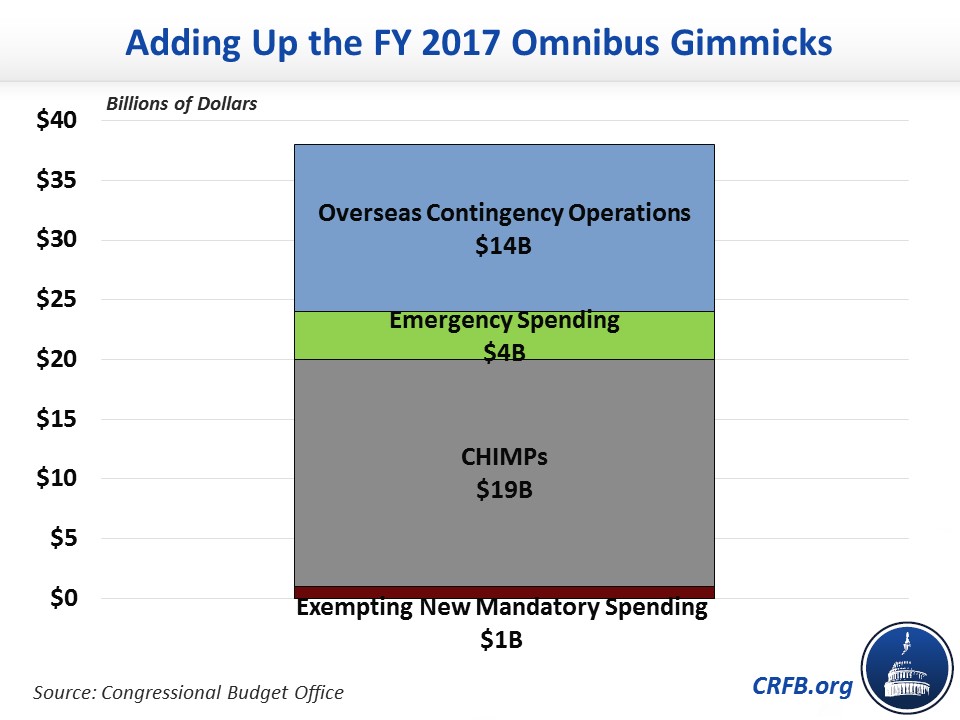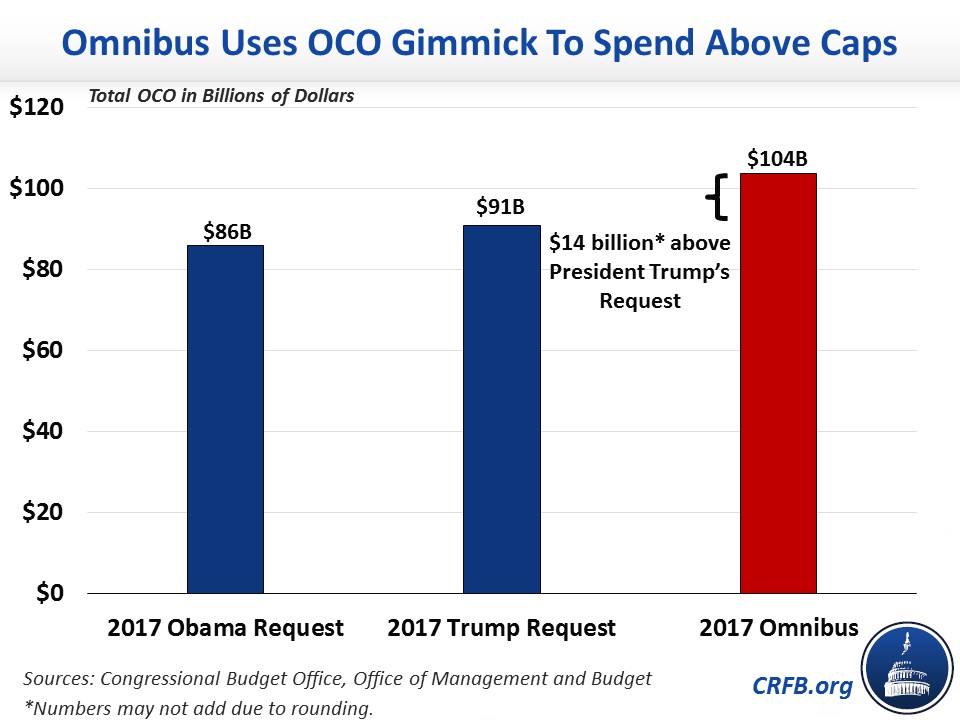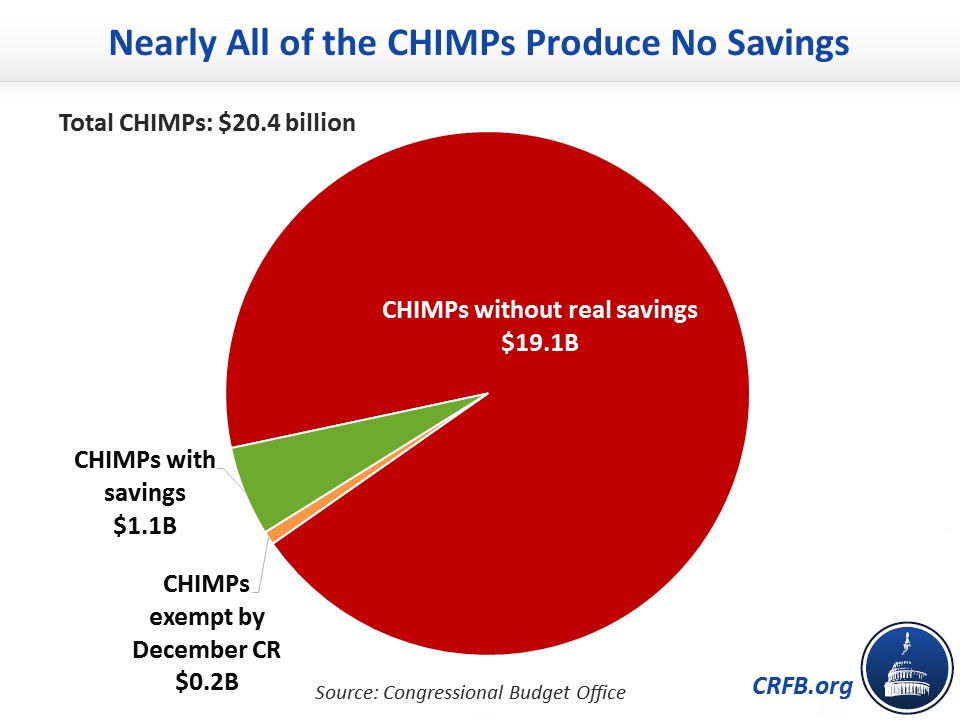CRFB Explainer: Gimmicks in the FY 17 Omnibus Bill
A negotiated deal to fund the government through the rest of Fiscal Year (FY) 2017 has passed the House of Representatives, with final passage expected before last week's continuing resolution expires. We are certainly glad that Congress avoided a shutdown and that they technically complied with the FY 2017 $1.07 trillion defense and non-defense discretionary spending caps. However, they did so only by employing upwards of $40 billion worth of budget gimmicks. Below, we explain how Congress used these gimmicks – many not for the first time – to circumvent statutory budget caps.
Broadly speaking, the $40 billion of gimmicks we identify from the bill come from four sources: improperly designated overseas contingency operations (OCO) spending not used for war purposes, abuse of the "emergency" designation, changes in mandatory programs (CHIMPs) that generate no real savings, and new mandatory spending increases that are not fully offset.

The OCO Gimmick – The overseas contingency operations (OCO) designation is designed to allow policymakers to spend above the statutory defense and non-defense discretionary caps in order to fund the wars in Afghanistan, Iraq, and elsewhere in the Middle East. The omnibus legislation includes $104 billion of OCO spending, much of which has nothing to do with the wars abroad and instead is being used to fund the normal defense and State Department budgets. This gimmick has been employed before, but its use is even larger this time. On the defense side, the omnibus spends $14 billion more than the total requested by President Trump (and $19 billion more than requested for the current year by former President Obama). This suggests that at a minimum, the omnibus includes $14 billion of OCO spending that doesn't belong there. The actual amount improperly designated is likely much higher since OCO spending already appears to include some improperly designated funds on both the defense and non-defense side.

"Emergency" Spending Gimmicks – As part of the annual appropriations process, policymakers can designate funds outside of discretionary spending caps to address things that are truly national emergencies – meaning they are urgent, necessary, and unforeseen. For example, when major epidemics like Zika and Ebola emerged, policymakers used the emergency designation for the unexpected funding to combat the diseases. However, sometimes policymakers try to slip other priorities in as "emergencies" in order to push spending above the caps. In this bill, just over $4 billion is classified as "emergency." But of these emergency funds, $1.5 billion is appropriated to the Federal Highway Administration, $800 million to community development, $400 million to wildfire management, $1 billion to the Corps of Engineers for construction and flood control, $200 million to the National Aeronautics and Space Administration (NASA), and $200 million to the Agriculture Department for emergency watershed programs. It is unclear whether all of these items are truly "emergencies" or are just another way to get around the discretionary spending caps.
Monkeying Around With CHIMPs – Changes in mandatory programs (CHIMPs) allow policymakers to cut mandatory budget authority (BA) to offset increases in discretionary BA. In total, the omnibus bill includes $20.4 billion of net CHIMPs; most of this represents phony cuts that would never have been spent otherwise or a timing shift that pushes spending from one year to the next. The major CHIMPs in the omnibus include: $8.2 billion in funds shifted in the Crime Victims Fund (CVF) from 2017 to 2018; a rescission of $7.6 billion of BA from the Children's Health Insurance Fund, which was not projected to be used anyway; and a $900 million rescission from the Federal Highway Administration that was also never projected to be spent. Only about $1 billion of the CHIMPs represent actual savings from a combination of small rescissions and cancellations. As a result, the omnibus includes $19 billion of CHIMPs that don't produce any actual savings.

Exempting New Mandatory Spending From PAYGO and Spending Limits – Under normal budget scoring rules, increases in mandatory spending included in appropriations bills count against the discretionary limit for the first year, and they must be offset over five and ten years under statutory pay-as-you-go (PAYGO) and Senate PAYGO. The omnibus bill includes about $1.6 billion of new mandatory spending provisions due to the permanent fix to miners' health benefits, increased funding to Puerto Rico for Medicaid, and a few other small provisions. This is partially offset by $1.4 billion savings from an extension of customs user fees in the tenth year of the budget window and a rescission of funds that CBO otherwise estimates would not be spent on Puerto Rico's Affordable Care Act (ACA) exchanges. The net result is a deficit increase of nearly $1 billion over five years and $250 million over a decade. Because the bill includes language waiving those costs from discretionary spending limits, statutory PAYGO, and Senate PAYGO, the costs of these provisions are not accounted for and are exempt from all budgetary discipline.
As a result of these gimmicks, the omnibus bill will increase spending and deficits by $40 billion or more over the next decade, violating the spirit of both the discretionary spending caps and PAYGO rules and law.
Sadly, use of these gimmicks is all too common. As policymakers work to develop next year's appropriations bills, it is time to put an end to gimmicks.


